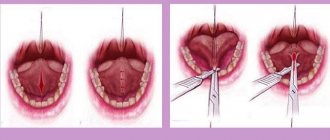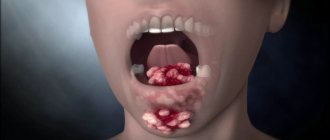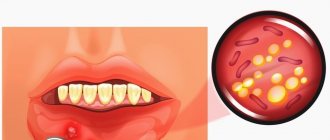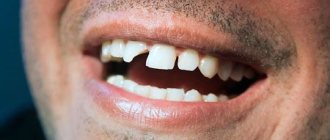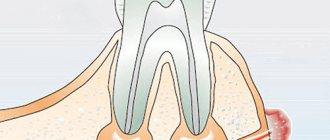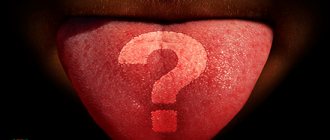The tongue is an important diagnostic organ. By its condition one can judge the functioning of the digestive, nervous, and immune systems.
Pain, burning, the appearance of cracks and erosions indicate the development of stomatitis, glossitis, and herpes infection.
Unpleasant sensations often occur after injuries, burns, eating irritating foods, or taking medications. In this article we will figure out why a person’s tongue may tingle and what to do.
Features of a smoker's tongue
Smoking negatively affects the entire body of the smoker and those around him. However, the most noticeable sign of a smoker is often the tongue, which changes its appearance over the course of smoking. Even a novice doctor can easily distinguish between the mouth of a non-smoker and a smoker.
Nicotine affects the sensitivity of taste buds, causing food to taste worse. Taste buds are necessary for a person not only to sense a certain taste, but also to improve the process of salivation, digestion and the secretion of gastric juice. This means that smoking directly affects the condition of the tongue, and indirectly changes the digestion process, slowing it down.
A smoker’s plaque is not just an accumulation of microbes and harmful microorganisms, but a change in its entire structure.
Example sentences
Here are several contexts when it is appropriate to use the verbs “ pinches” and “pinches” in colloquial speech:
- I got a sunburn yesterday that really stings.
- The alcohol bandage stings the patient's wound.
- Vlada’s wound stings when his mother treats her knee with green paint.
- Kolya pinches Yulia’s hand so that she would quickly pay attention to him.
- Grandma Tanya always pinches the cheeks of small children.
- My cousin pinches my stomach to keep me awake.
- The bluish liquid first stings the hand and then leaves a small burn.
- On a green lawn, a cow is nibbling lush grass.
- A sheep is nibbling on a neighbor's bush that Uncle Senya planted.
Possible problems with the tongue from smoking
It is worth remembering that a change in the condition of the oral cavity is a signal of negative changes in the entire body.
Why does my tongue sting when smoking?
For most smokers, after another cigarette, their tongue begins to tingle. The reasons why your tongue stings when you smoke can be:
- formation of ulcers in the mouth;
- stomatitis;
- presence of nodules in the oral cavity;
- burn (both from hot and cold);
- dental injury.
Pain and burning sensation in the tongue after smoking
When smoking, the tongue burns and pain occurs for the same reasons as in the case of pinching in the mouth. Most likely, from prolonged smoking, ulcers or nodules have formed on the surface of the smoker’s tongue, which are characterized by increased sensitivity.
When exposed to nicotine, the sensitivity of the injured areas increases, pain and burning are felt. Moreover, ulcers can lead to constant discomfort over time.
Causes of plaque on a smoker's tongue
There may be several reasons leading to the formation of plaque. The most harmless and safer for humans are the following:
- saliva is produced in insufficient volume or its composition changes;
- the surface of the cavity dries out due to constant mouth breathing;
- insufficient oral care.
On microparticles of food that remain throughout the oral cavity, microbes multiply, during the life of which acids are released. They have a detrimental effect on the condition of the surface of the tongue, and subsequently on its entire structure.
REFERENCE! The development of some infections in the body is clearly imprinted on the condition of the tongue. Thanks to this, doctors can make a preliminary diagnosis even during the initial examination.
The next group of reasons relates to impaired motility (motor activity) of the gastrointestinal tract. Some diseases of the stomach or duodenum, as well as problems with the bile ducts, lead to the release of chemically active and acidic components into the oral cavity. This can be bile or juices (for example, pancreatic or gastric) and their mixtures.
Chronic diseases (and not only infectious ones) lead to the appearance of plaque on the tongue. This happens due to atrophy of its surface structures.
Associated symptoms and what do they indicate?
The table shows symptoms and diseases:
| Clinical signs | Diseases |
| The tip of the tongue stings | Burn, leukoplakia, stomatitis |
| Stings under the tongue | Fungal, bacterial infection, inflammation of the salivary glands |
| The tongue is covered with a white coating | Gastrointestinal diseases, candidiasis |
| Lips are dry | Allergic, drug stomatitis, lichen planus |
| Tongue stings constantly | Dysbacteriosis, increased stomach acidity, cholecystitis |
| Stings tongue and throat | Fungal stomatitis, herpes infection, food allergy |
| Tongue stings in the morning | Poor quality toothpaste, stomatitis |
| Rash on tongue | Herpetic stomatitis, allergies, thermal burns |
| Tongue red, crimson | Consumption of coloring foods, scarlet fever, tonsillitis, Kawasaki disease, food poisoning, vitamin B deficiency₁₂ |
Near and distant prospects
Experts can even determine smoking experience by appearance. If only a whitish coating is noticeable in a novice smoker, then in experienced smokers the coating becomes thicker and changes its color to brown.
Gradually, bacteria, protozoan microorganisms and viruses appear on the tongue of such people.
Stages of transformation of the oral mucosa during smoking:
- a primary burn is characterized by the death of the surface layer of the epithelium - it is for this reason that a white coating appears;
- then the mucous membrane dies off, it is already deep and irreversible - the reason for the appearance of yellow or brown plaque.
The second phase indicates disruptions in the functioning of the oral mucosa: sensitive, protective and motor functions disappear.
Smokers with experience that the language has not only changed in appearance, but has even become different in sensation. Such people claim that the organ “has become wooden.” "doesn't listen." This indicates a violation of speech articulation due to the constant influence of nicotine on the tongue muscle.
And from the smoker’s mouth, in turn, comes a persistent unpleasant smell of tobacco. It also develops a large number of harmful microorganisms, protozoa and viruses. When exposed to so many organisms, the oral mucosa becomes unable to perform its functions.
Causes other than dental
A burning tongue can be caused by factors unrelated to dentistry:
- Glossitis and stomatitis are quite often diagnosed in patients with HIV infection
psychological disorders;
- heartburn;
- drug therapy;
- hormonal imbalance;
- endocrine diseases;
- avitaminosis;
- Iron-deficiency anemia;
- blood diseases;
- previous radiation and chemotherapy;
- unbalanced diet.
Glossitis and stomatitis are quite often diagnosed in patients with HIV infection, diabetes mellitus, and hyperthyroidism of the thyroid gland.
Disruption of the normal microflora of the oral cavity occurs in chronic diseases of the digestive tract.
How to rid a smoker's tongue of plaque
Seeing changes occurring in the tongue, smokers rush to seek medical help. But dentists say that it will be possible to improve the condition of the oral mucosa only after giving up cigarettes.
All remedies have only a temporary effect. However, you shouldn’t give them up either. After all, this way the condition of the surface of the tongue can at least be kept in one state, preventing it from deteriorating.
The surface of the tongue is cleaned using both improvised means and special hygiene products (usually graters located on the back of the toothbrush are used).
You can rinse the mucous membranes with both ready-made store-bought products and homemade ones. The simplest recipe is a soda solution. You can also use a decoction of antiseptic herbs (sage or chamomile).
IMPORTANT! Cleaning the oral cavity of plaque will not restore functionality. To save the mucous membrane, it is important to stop smoking and continue to clean the surface mechanically and with solutions.
In addition to quitting smoking, it is important for smokers to change their diet and daily habits. You need to drink more (plain water, compotes or herbal teas are fine), limit the consumption of fatty, fried, salty and smoked foods. Monitor the regularity of stool and the general condition of the intestines and stomach.
What dangers can plaque and untimely removal pose for a smoker?
We have already said that plaque is not only unsightly, but also dangerous. The formation of plaque indicates tissue destruction, and therefore a deterioration in the functionality of the organ. Its main function is taste sensitivity and transmission of further signals to the brain. If no signals were received, the body did not understand that the digestion process should begin. It is for this reason that digestive problems occur.
Also, plaque in a smoker is a sign of the presence of viruses and microbes that, with saliva, enter the internal organs through the mucous membrane. All harmful microorganisms continue to multiply in the body, disrupting the functioning of each organ separately.
What should a smoker do to prevent plaque?
The basis of any prevention is regular (twice a day) oral hygiene and periodic (at least once a year) dental examinations.
It would also be a good idea to rinse daily with herbal decoctions or soda solution. Dentists recommend rinsing the mucous membrane after every cigarette, meal, and cup of coffee. You can purchase special rinses. It is desirable that they have an antibacterial effect.
It is recommended to chew propolis regularly (every 2-3 days). It has a powerful antibacterial effect and fights inflammation.
Can a smoker get tongue cancer from smoking?
When smoking, the tongue is the first organ to take the hit of nicotine. With constant smoking, the organ receives microtraumas, which increase over time. Also, other formations that can develop into cancer may appear on the mucous membrane due to tobacco smoke.
IMPORTANT! Tongue cancer is dangerous because it can only be diagnosed in late stages, and it develops rapidly.
The first signs are the appearance of ulcers and seals. At the beginning of the disease, ulcers and seals have clear boundaries, but as it progresses, the boundaries are erased, and the edges rise upward and resemble rollers in appearance.
Over time, the smoker develops pain, swelling of the face, and difficulty opening the mouth and, accordingly, eating.
Uvula body cancer
The most common type of oncology. The malignant neoplasm affects the middle of the tongue, as well as its lateral parts.
Tongue root cancer
Root damage is characterized by severe pain when swallowing food. This type of oncology is less common compared to the previous one.
The disease also has a second name - oropharyngeal cancer. In this case, the tumor is located at the back of the mouth.
The pathological process is aggressive and treatment is extremely rare.
Cancer of the lower part of the uvula
The pathology is characterized by the presence of a tumor on the lower part of the uvula. In rare cases - under the tongue.
Experts consider three types of neoplasms on the tongue:
- Ulcerative. The disease begins with the appearance of a lump that develops into an ulcer. In this case, the ulcer bleeds almost constantly, and the patient feels severe pain.
- Infiltrative. The tumor that appears in this case is solid. And she herself is covered with white spots. The patient complains of severe pain in the affected area.
- Papillary. The tumor is hard, rises above the rest of the tissue, and is characterized by dense plaques.
Oral hygiene devices
If the coating is dense and has already acquired a yellowish or brown tint, then it is recommended to combat it with the help of special devices.
Spoon. It resembles a spatula and is made of durable plastic that bends well. The algorithm for use is simple: place it as close to the tongue as possible and move it from base to tip.
REFERENCE! The special device can be replaced with a regular silver spoon.
Scraper. The device is somewhat similar to a loop. They are also made from highly flexible plastic and have dense, tiny bristles on the surface.
Toothbrush. Most modern toothbrushes are characterized by the presence on the back of silicone inserts designed to clean the tongue. It is important to pay attention to this point when purchasing a brush.
IMPORTANT! Procedures for removing plaque should be carried out twice a day. Otherwise, all efforts will be in vain. It is also important to remember that all of the listed items are personal hygiene devices and should only be used individually; you cannot purchase one spoon for all family members. This only increases the risk of developing oral diseases.
Diagnostics
In most cases, the doctor makes a diagnosis based on the results of an external examination and questioning of the patient.
If your tongue stings, swells or hurts, you need to visit a dentist.
In most cases, the doctor makes a diagnosis based on the results of an external examination and questioning of the patient.
To determine the etiology of the disease, scrapings are taken from the surface of the mucous membranes for cytological, bacteriological, and histological studies.
Viral infections are detected using PCR diagnostics and blood ELISA. Differential diagnosis is carried out with tongue cancer and secondary syphilis.

